Lesson 12
By Mary Ann Boysen
Master watercolor painting lace without photo realism. Select a very small portion of the lace and make a fairly detailed pencil sketch of it on my paper. Then I repeat this design in a looser manner as many times as needed to complete my still life.
Once you have this design in your mind, you can repeat it over and over on your page without looking at the lace again. The viewer is never aware that you have taken such liberties with the pattern, and they are very impressed with your ability to do what looks like an intricate drawing or painting.
Master watercolor painting lace without photo realism. Select a very small portion of the lace and make a fairly detailed pencil sketch of it on my paper.
Then I repeat this design in a looser manner as many times as needed to complete my still life.
Place something dark beneath the lace so that you can see the pattern more clearly, then carefully draw the basic image of the lace. Then draw the
repeated pattern, and repeat this procedure several times, your mind will have memorized the basic pattern. It is just like practicing the piano.
Repeat, repeat, repeat, until your mind and fingers have it memorized. It is NOT necessary to draw in every little hole in the lace....just the main pattern.
Do this on a piece of paper. When you have it memorized it is then time to draw it on your watercolor paper.
The other details can be put in with a brush when you have begun to paint. Even then, it is not necessary to paint every little hole. Let the viewer's mind
imagine what he is seeing. Click on this image to see the larger picture.
Learning the pattern of lace
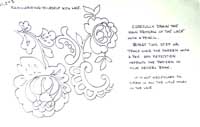
It is important to spend a little time selecting, drawing, and memorizing a small pattern in the lace object that you will use in your painting.
Once you have drawn it, draw it again.
Once you have this design in your mind, it is time to paint. The viewer is never aware that you have any liberties with the pattern, and they
are very impressed with your ability to do what looks like an intricate drawing or painting. They will never know if you have slightly changed
the pattern. Now you can put this on your watercolor paper and begin to paint. I dare say, that you may not even have to draw it on the paper,
but that you will have memorized the shapes just because you have drawn it enough times to know exactly where the negative shapes
(background shapes in this case) are.
Here I have taken some liberties with color. I carefully paint clear water in each negative space, then drop a color with the tip of my brush
and let it flow into the wet area, trying not to let brush stokes show. If the area is not totally wet, you might have to help it along with the tip
of your brush. In an adjoining space, I repeat the process, but might drop in another color, and with the brush, blend the two colors at their edges.
This is only for dramatic effect. Perhaps you would prefer the same color in the background all over the painting. The choice is certainly yours.
As you continue this process you might not use a pencil at all. And if you make a mistake, I doubt that anyone will notice. Just keep repeating
the pattern as well as you can remember it. By this time you might even be able to see how it would look if it were folded. The pattern, like
shadows in the landscape, will follow the flow of the fabric.
Click on this image to see the larger picture.
hen try to paint only the “holes” in the lace. 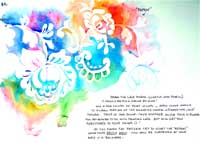 Probably the most difficult thing to learn Probably the most difficult thing to learn
when painting is how to determine negative shapes. It is in discovering this that an entire new possibility and challenge is presented
to us as artists.
When you get to this point in the painting, you can add further detail (the little holes in the lace). Don't make it such a difficult thing
by counting the holes and trying to make them exact! Use either a 1/8" flat brush or a small round brush to make the holes. If they
are square or rectangular in shape, the flat brush is appropriate. If they are more like little circles, the round brush is the one to use.
It is not necessary to paint every little hole. You can start with one area, and when you get to the edge of your paper, you can fade
out the color of the holes so that you eye is on the focal point and not carried off the page by all the detail at the edges.
When you have familiarized yourself with this repetitive pattern, you may begin to design your work of art. At this point you can
take liberties with the pattern.
Probably the most difficult thing to learn when painting is how to determine negative shapes. It is in discovering this that an entire new
possibilityand challenge is presented to us as artists. When you get to this point in the painting, you can add further detail (the little
holes in the lace).
Don't make it such a difficult thing by counting the holes and trying to make them exact! Use either a 1/8" flat brush or a small round
brush to make the holes. If they are square or rectangular in shape, the flat brush is appropriate. If they are more like little circles,
the round brush is the one to use.
It is not necessary to paint every little hole. You can start with one area, and when you get to the edge of your paper, you can fade
out the color of the holes so that you eye is on the focal point and not carried off the page by all the detail at the edges.
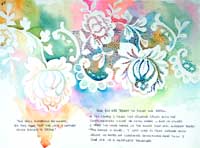
You may begin by creating several shadow washes to create the folds in the proposed lace. Then it is easier to paint the lace to create folds by
having the pattern of the lace follow the shape of the shadow.
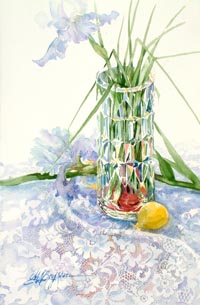
It is not necessary to be exact in your painting of the pattern which is photo-realism. All you want to do is create the illusion that you have gone
to great detail to represent the pattern. Crystal is defined by the shapes of the objects seen through its facets. The facets have a shape which you
will need to define more accurately than the shapes of the objects seen through it. Those can be faked quite easily.
If the crystal is extremely faceted, those shapes can also be suggested rather than accurately drawn. If it is a more simple design, you must
memorize the shapes and draw it accurately just at you did with the lace pattern.
You can see the colors and the folds in the cloth through the vase and the crystal paper weight. It doesn't have to be like a photograph.
Just the suggestion of an object beyond the glass tells the viewer that it is transparent.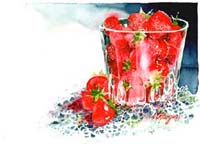
I think that I digress back to painting crystal with this subject, but usually you see both crystal and lace in the same painting.
<< Lesson 11: Watercolor Painting Crystal
Lesson 12: Learning to paint with Green!>>
Return to Watercolor Lessons
Watercolor Painting Tips
Return to Watercolor Techniquess

|

